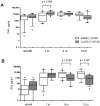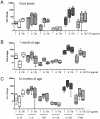Age-dependent maturation of Toll-like receptor-mediated cytokine responses in Gambian infants
- PMID: 21533209
- PMCID: PMC3076452
- DOI: 10.1371/journal.pone.0018185
Age-dependent maturation of Toll-like receptor-mediated cytokine responses in Gambian infants
Abstract
The global burden of neonatal and infant mortality due to infection is staggering, particularly in resource-poor settings. Early childhood vaccination is one of the major interventions that can reduce this burden, but there are specific limitations to inducing effective immunity in early life, including impaired neonatal leukocyte production of Th1-polarizing cytokines to many stimuli. Characterizing the ontogeny of Toll-like receptor (TLR)-mediated innate immune responses in infants may shed light on susceptibility to infection in this vulnerable age group, and provide insights into TLR agonists as candidate adjuvants for improved neonatal vaccines. As little is known about the leukocyte responses of infants in resource-poor settings, we characterized production of Th1-, Th2-, and anti-inflammatory-cytokines in response to agonists of TLRs 1-9 in whole blood from 120 Gambian infants ranging from newborns (cord blood) to 12 months of age. Most of the TLR agonists induced TNFα, IL-1β, IL-6, and IL-10 in cord blood. The greatest TNFα responses were observed for TLR4, -5, and -8 agonists, the highest being the thiazoloquinoline CLO75 (TLR7/8) that also uniquely induced cord blood IFNγ production. For most agonists, TLR-mediated TNFα and IFNγ responses increased from birth to 1 month of age. TLR8 agonists also induced the greatest production of the Th1-polarizing cytokines TNFα and IFNγ throughout the first year of life, although the relative responses to the single TLR8 agonist and the combined TLR7/8 agonist changed with age. In contrast, IL-1β, IL-6, and IL-10 responses to most agonists were robust at birth and remained stable through 12 months of age. These observations provide fresh insights into the ontogeny of innate immunity in African children, and may inform development of age-specific adjuvanted vaccine formulations important for global health.
Conflict of interest statement
Figures









References
-
- UNICEF. UNICEF; 2009. Reducing Child Mortality: Millennium Development Goals.
-
- Siegrist CA. Neonatal and early life vaccinology. Vaccine. 2001;19:3331–3346. - PubMed
Publication types
MeSH terms
Substances
Grants and funding
LinkOut - more resources
Full Text Sources
Research Materials
Miscellaneous

